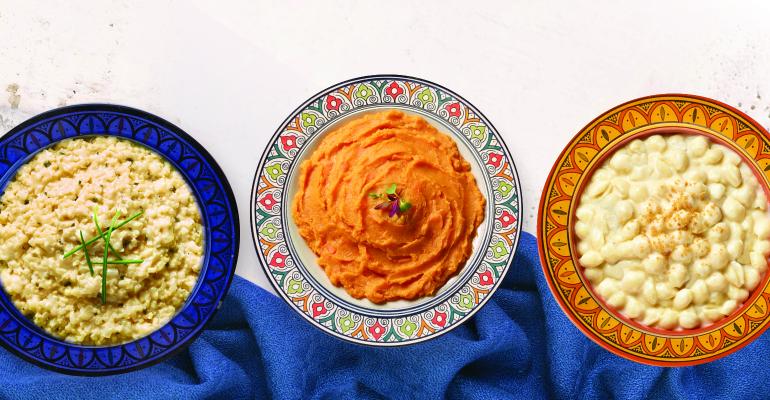Sponsored by Blount Fine Foods
Pairing flavorful side dishes with the protein on the plate has emerged as a smart — and profitable — strategy for operators looking to cater tor today's more demanding consumers. Instead of languishing in the “sides” section of the menu, well-crafted side dishes are moving into a starring role by helping to elevate the plate as a whole.
Experts say the time for pairing has come as a result of two consumer trends: a desire among Americans for more plant-based fare and a growing demand for clean label products.
A Hartman Group survey reveals that 54 percent of consumers would like to eat more plant-based foods. Their reasons include a desire for a more healthful lifestyle, weight loss and fiber intake, among others.
Meanwhile, diners are demanding more clean label menu items, which shun the use of artificial preservatives, colors and flavorings. In short, consumers want to be able to pronounce the names of the ingredients in the foods they eat.
Operators can optimize both trends with side dishes.
But as plant-based foods continue to grow in popularity, animal proteins show no signs of disappearing from the center of the plate. Even as many nutritionists advise Americans to eat smaller portions of beef, this protein remains a dining-out favorite. At the same time, people are eating just as much chicken, pork, fish and seafood as ever.
Increasingly, operators and chefs are finding ways to accommodate all of these movements by making their plates more exciting and complementing the center-of-the-plate proteins with exciting and flavorful side dishes
Pairing sides provides culinary opportunities
One key to pairing sides with proteins is to feature side dishes that possess an added panache. For example, rather than simply menuing steamed asparagus, offer roasted asparagus spears with asiago and bacon. And for a twist on the traditional mixed vegetables, devise something more creative like baby beet and carrot salad with yogurt dressing.
Keep in mind too that strategic pairing requires that each item being paired will complement the other in flavor and texture, bringing out the best characteristics of each. If the chicken dish featured on the menu is served with a sauce, do not offer a similarly sauced side dish. Create a contrast in flavor and texture.
Steak lovers often enjoy potato with their selection, but to create a more exciting combination, it makes sense for the kitchen to go beyond conventional mashed or baked accompaniments and serve instead roasted Dijon potatoes or a potato, squash and goat cheese gratin. Mashed cauliflower is different, delicious and low in carbohydrates for those who want the flavor of potatoes but not the carbs. Climb Elevated Eatery in Lake City, Colo., offers fresh cut truffle fries with parmesan cheese and fresh herbs.
Upscaled greens and salads can be paired with virtually any animal protein. Also, roasted vegetables add a complementary flavor profile — together with the perception that the chef has taken extra care to roast them rather than simply boil or steam them. Ruth’s Chris Steak House, for example, serves roasted Brussels sprouts tossed with bacon.
When pairing, it is a good idea to market the pairs on the menu. Using the term “paired” with protein and side dishes signals to the diner that something new is happening in your kitchen. To leave the pairing opportunities flexible, employ a specials menu or have the waitstaff describe the suggested paired items.
Offering upscale sides can be easy and low labor
Savvy operators and chefs want creative sides paired with protein to increase profitability not labor. A solution to this dilemma is offered by Blount Fine Foods, which features a wide array of flavorful sides that are ready to use. In addition, they offer clean label products that contain no added preservatives, colors or flavorings.
Bob Sewall, executive vice president of sales and marketing at Blount Fine Foods, says “You don’t have to have any extra labor to create great pairings. It’s a great opportunity to upscale a menu offering. Plus, our products are labor free, fresh and clean label.”
Sewall points out that while most restaurants tend to be locked into their proteins, one way of adding excitement is to pair them with great side dishes like broccoli rabe with white beans. “This dish can go with steak, fish or pork,” he says. “It’s very versatile.”
Or take a fried chicken dish and pair it with cheesy polenta. “It makes it different from traditional mac and cheese or French fries,” he says.
Blount also features a number of certified organic sides. Sewall notes that this adds a perception of even better quality in the minds of diners.
The strategy of offering intriguing, elevated sides can work in any segment of the foodservice industry, from colleges and universities to fine dining. Pairing innovative sides with protein adds extra excitement, making menu offerings on-trend and providing the opportunity to increase profits.





